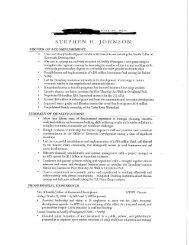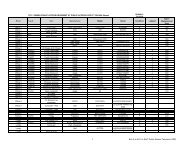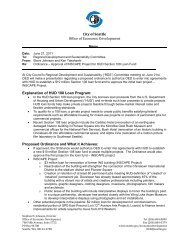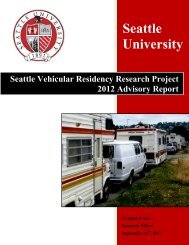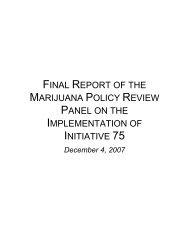2013 Water System Plan, Volume II - Seattle City Clerk's Office - City ...
2013 Water System Plan, Volume II - Seattle City Clerk's Office - City ...
2013 Water System Plan, Volume II - Seattle City Clerk's Office - City ...
Create successful ePaper yourself
Turn your PDF publications into a flip-book with our unique Google optimized e-Paper software.
pipe. The annular space between the two pipes is sometimes filled with grout. The design<br />
engineer should carefully consider the hydraulic implications of reducing the pipeline diameter.<br />
5.6.5.2 Relining<br />
If video inspection of the pipeline interior shows significant deterioration of the lining, relining<br />
of the pipe may be possible. Pipes are relined by thoroughly cleaning the existing pipe interior<br />
then using a machine to spray-coat new cement mortar lining inside the pipe. The method used<br />
depends on pipe size. The relining can be designed to strengthen the pipe through use of a<br />
structural mesh embedded in the spray-coated cement mortar lining.<br />
5.6.5.3 Cathodic Protection<br />
Cathodic protection is one method SPU uses to rehabilitate existing water pipelines. For more<br />
detail on cathodic protection for distribution and feeder mains, see DSG section 5.6.8 and DSG<br />
Chapter 6, Cathodic Protection.<br />
5.6.6 Emergency Pump Connections<br />
In some emergencies, a connection between two nearby pipelines may be needed. If the<br />
pipelines operate in different pressure zones, then a pump may be needed between the two<br />
lines. If possible, use an existing interconnection. If no inter-connecting pipe structure is<br />
available, SPU recommends using a nearby blow-off location and installing a pump between the<br />
two pipelines.<br />
5.6.7 SCADA<br />
See DSG Chapter 10, Instrumentation & Control, for SCADA system design. The design engineer<br />
should consider whether any monitoring or controls are needed and if the controls should be<br />
linked to the system wide SCADA system.<br />
5.6.8 Corrosion Control<br />
Corrosion control of SPU pipelines comes from both active and passive protection systems. Bare<br />
metal steel or ductile iron pipe will rust when exposed to corrosive soils or water if no<br />
protection system is installed. The rate of corrosion depends on the corrosivity of the<br />
environment (typically soil or water). The rate of corrosion is mostly a function of how well the<br />
environment conducts electrical current.<br />
Resistivity plays a key role in corrosion control of pipelines. Resistivity refers to the resistance of<br />
the environment to promote electrical current flow. When the resistivity of water or soil is high,<br />
less current can flow through that environment and the rate of corrosion is lower. For internal<br />
corrosion (inside of pipes), water resistivity is constant. For external corrosion (exterior surfaces<br />
of pipes), soil resistivity is highly variable. SPU GIS maps show the results of tests taken to date<br />
for soil resistivity. SPU staff can test for specific areas for soil resistivity.<br />
The internal corrosion of pipes is managed through a combination of water chemistry<br />
adjustments and the use of internal linings..<br />
SPU controls external (on the soil-pipe interface) corrosion through one of three methods:<br />
1. Testing the soil environment for resistivity<br />
5-36 SPU Design Standards and Guidelines



